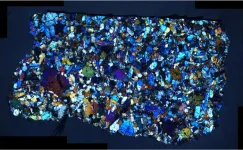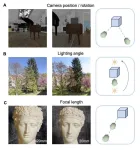(Press-News.org)
Converting home heating systems from natural gas furnaces to electric heat pumps is seen as a way to address climate change by reducing greenhouse gas emissions.
But a new University of Michigan study of 51 Southeast Michigan households shows that switching to efficient, cold-climate heat pumps would increase annual utility bills by an average of about $1,100.
Home weatherization upgrades, such as adding attic insulation and sealing around doors and windows, could help reduce utility bills and make electric heating more affordable.
But those energy retrofits are expensive and are likely beyond the reach of many low-income households, which could lead to what the researchers call an energy poverty trap.
"The clean energy transition is hindered by an energy poverty trap because the extensive retrofits needed to make electrification affordable are themselves too expensive for low-income households," said study lead author Claire McKenna, a doctoral candidate at the U-M School for Environment and Sustainability.
"Our findings suggest that heat pumps are not a feasible economic alternative for households currently using natural gas, unless governments offset energy cost premiums through public funding. Policymakers should act to help lower the operating costs of heat pumps compared to natural gas for low-income households in cold climates."
The study was published online May 31 in the peer-reviewed journal Resources, Conservation & Recycling.
Residential heat pumps are reversible air conditioners that use electricity to move heat from one place to another, providing both heating and cooling in a building. In the winter, heat pumps move heat from the outdoors into a building, and in summer they move heat from the inside to the outside.
Heat pumps are growing in popularity and for the last two years have outsold gas furnaces in the United States.
For their study, U-M researchers analyzed utility bills, thermostat settings and energy burdens—the proportion of income that households spend on electricity and gas costs—for 51 homes in Wayne and Washtenaw counties, half of them below median income levels. Then they used a heat pump coefficient-of-performance model to determine energy cost and energy-burden impacts of switching to a heat pump.
The researchers also hired a contractor to conduct energy assessments of the homes and to provide energy-retrofit recommendations, including estimated costs and savings. Members of the research team are from U-M's School for Environment and Sustainability, the Institute for Social Research and the School of Public Health.
The researchers found that converting homes to electric heat pumps would increase annual energy costs 58%, on average. Below-median-income households, which today experience a median energy burden of 6% (which is considered high and is twice the national average), would see that burden rise to 10% if they switched from natural gas heating to electric heat pumps.
Weatherization could offset the increase, bringing energy burdens back down to pre-electrification levels. However, median payback time for the retrofits was 24 years, making them "infeasible for the poorest," according to the study authors.
And it's not just the lowest income households that would feel the pinch of the heat pump transition.
Households earning $50,000 or more annually, which currently have a median energy burden of 2.6%, would see that number rise by more than one percentage point, on average, indicating that "energy burden could become a concern for households which are currently energy secure," according to the study.
The 51 homes in the study were, on average, 60 years old and were built in an era when Michigan did not have energy-efficient building codes. The cost of the average retrofit package recommended by the energy-audit contractor was $7,628.
On top of that, efficient cold-weather residential heat pumps typically cost between $5,000 and $10,000 for the hardware, and installation costs can double the total price tag.
"The upfront costs of weatherization and heat-pump installation can be very high," said study senior author Parth Vaishnav of the School for Environment and Sustainability. "Our findings clearly demonstrate the challenges associated with heat pump adoption in cold climates."
In the study, the lowest-income households had the least energy-efficient homes and also used the lowest amount of energy. That finding suggests that low-income households are likely not using enough energy to meet their health, safety and comfort needs, McKenna said.
Given that households below median income currently have a 6% median energy burden on their existing natural gas heating systems, the transition to electric heat pumps "would severely worsen existing energy insecurity," the study authors wrote.
"That, in turn, could increase coping behaviors like trading off paying utility bills for paying for rent or food, or the underconsumption of energy in households that struggle to pay their bills. This could have huge ramifications for health," said study co-author Carina Gronlund, an environmental epidemiologist at the U-M Institute for Social Research and the School of Public Health.
The researchers identified three ways that policymakers can help lower heat pump costs for low-income households in cold climates. First, government-sponsored initiatives to advance more energy-efficient heat-pump technology are essential.
Second, state regulators should exercise "a more robust scrutiny" of utility company returns and create more opportunities to improve customer outcomes in the rate-making process. Most households in the U-M study were DTE customers, with a few supplied by Consumers Energy.
Third, states should consider implementing "percentage of income payment plans," known as PIPPs, which place a cap on energy expenditures relative to household income. Such programs can be paired with federal- and state-funded retrofit programs to simultaneously improve the building stock and mitigate energy poverty, according to the study authors.
"The economics of electrification are adverse for the existing housing stock in cold climates," the authors concluded. "Policy action is needed to make heating electrification viable."
The study was funded by the U-M Graham Sustainability Institute's Heating with Justice project and by the U.S. Department of Energy Building Technologies Office Innovation in Buildings graduate research fellowship.
Study: Heating with justice: Barriers and solutions to a just energy transition in cold climates (DOI: 10.1016/j.resconrec.2024.107699)
END
Overcoming barriers to heat pump adoption in cold climates and avoiding the 'energy poverty trap'
2024-05-31
ELSE PRESS RELEASES FROM THIS DATE:
A new way to see viruses in action
2024-05-31
A new, nano-scale look at how the SARS-CoV-2 virus replicates in cells may offer greater precision in drug development, a Stanford University team reports in Nature Communications. Using advanced microscopy techniques, the researchers produced what might be some of the most crisp images available of the virus’s RNA and replication structures, which they witnessed form spherical shapes around the nucleus of the infected cell.
“We have not seen COVID infecting cells at this high resolution and known what we are looking at before,” said Stanley Qi, ...
Wealthier neighborhoods in Boulder saw lower bee diversity
2024-05-31
Community gardens in higher-income Boulder neighborhoods have fewer varieties of bees than their medium-income counterparts, new University of Colorado Boulder research suggests. Scientists suggest that people in these neighborhoods tend to apply more landscaping practices, such as using fertilizers, which could impact bees’ habitats.
The finding appeared May 22 in the journal Urban Ecosystems.
“Bees are so important for local ecosystems through their pollination services. The landscape would not look the same without our pollinators,” ...
Advancing excellence top priority for new board chair
2024-05-31
At its annual meeting on Thursday, the University of Miami Board of Trustees (BOT) confirmed Manuel “Manny” Kadre as its new chair, Wayne Chaplin and Bill Morrison as new vice chairs, and welcomed a slate of new trustees.
Kadre, chairman and chief executive officer of MBB Auto Group as well as a senior executive and shareholder of a number of beverage, automotive, health care, and real estate companies, first joined the board as a trustee in 2004. He served as a vice chair since June 2021 and more recently as board chair-elect.
“The University has one of the great reputations and brand names anywhere in the world,” ...
Martian meteorites deliver a trove of information on Red Planet’s structure
2024-05-31
Mars has a distinct structure in its mantle and crust with discernible reservoirs, and this is known thanks to meteorites that scientists at Scripps Institution of Oceanography at UC San Diego and colleagues have analyzed on Earth.
Meteorites that formed roughly 1.3 billion years ago and then ejected from Mars have been collected by scientists from sites in Antarctica and Africa in recent decades. Scripps Oceanography geologist James Day and his colleagues report May 31 in the journal Science Advances ...
Can ketones enhance cognitive function and protect brain networks?
2024-05-31
Researchers at the Del Monte Institute for Neuroscience at the University of Rochester have identified mechanisms in the brain’s hippocampal network that are rescued by ketones. These findings build on previous research showing that ketones can alleviate neurological and cognitive affects.
As we age our brain naturally becomes more insulin resistant. This creates a breakdown in communication between neurons, causing symptoms like changes in mood, cognitive decline, and eventually neurodegeneration. Nathan A. Smith, MS, PhD ('13), associate professor of Neuroscience, and fellow researchers studied the mechanisms in the brain that break down when insulin resistance is suddenly ...
AMS Science Preview: Sea-ice loss may accelerate; tornadoes and flying cars
2024-05-31
The American Meteorological Society continuously publishes research on climate, weather, and water in its 12 journals. Many of these articles are available for early online access–they are peer-reviewed, but not yet in their final published form.
Below is a selection of articles published early online recently. Some articles are open-access; to view others, members of the media can contact kpflaumer@ametsoc.org for press login credentials.
JOURNAL ARTICLES
Large-Scale Climate Modes Drive Low-Frequency Regional Arctic Sea Ice Variability
Journal of Climate
Arctic sea ice loss may accelerate in the coming decade. This study examined the dominant natural climate ...
UT Arlington, Microsoft host AI “Prompt-a-Thon”
2024-05-31
Faculty, staff and researchers from higher education and K-12 schools throughout Texas gathered in Arlington for the state’s first “Prompt-a-Thon” hosted by Microsoft and UTA’s offices of Research and Innovation and Information Technology. Together, educators and researchers learned how to best use artificial intelligence (AI) tools to improve their work.
“This Prompt-a-Thon is a significant step toward promoting AI literacy across multiple universities and establishing UTA as a frontrunner for AI use in the state,” said Jeremy Forsberg, associate ...
Children’s visual experience may hold key to better computer vision training
2024-05-31
UNIVERSITY PARK, Pa. — A novel, human-inspired approach to training artificial intelligence (AI) systems to identify objects and navigate their surroundings could set the stage for the development of more advanced AI systems to explore extreme environments or distant worlds, according to research from an interdisciplinary team at Penn State.
In the first two years of life, children experience a somewhat narrow set of objects and faces, but with many different viewpoints and under varying lighting conditions. Inspired by this developmental insight, the researchers introduced a new machine learning approach that uses information about spatial position to train AI visual ...
2024 Mahoney Life Sciences Prize goes to food scientist Lynne McLandsborough
2024-05-31
University of Massachusetts Amherst food scientist Lynne McLandsborough has won the 2024 Mahoney Life Sciences Prize for her research that offers a solution to a sticky sanitation and food safety dilemma hounding the peanut butter and chocolate industries.
“I was really surprised and excited,” McLandsborough says of winning the prize. “I think our research is innovative and there’s a need in the industry. It was a fun project.”
She is already in talks with Mars, the world’s ...
Ancient medicine blends with modern-day research in new tissue regeneration method
2024-05-31
For centuries, civilizations have used naturally occurring, inorganic materials for their perceived healing properties. Egyptians thought green copper ore helped eye inflammation, the Chinese used cinnabar for heartburn, and Native Americans used clay to reduce soreness and inflammation.
Flash forward to today, and researchers at Texas A&M University are still discovering ways that inorganic materials can be used for healing.
In two recently published articles, Dr. Akhilesh Gaharwar, a Tim and Amy Leach Endowed Professor in the Department of Biomedical Engineering, and Dr. Irtisha Singh, assistant professor in the Department of Cell Biology ...






